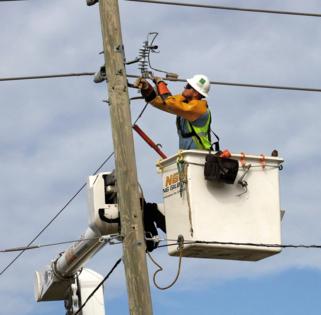While Hurricane Milton darkened Central Florida, the lights stayed on in Winter Park. Here's why
Published in Weather News
ORLANDO — As Hurricane Milton pelted Winter Park with gusty winds and rains, televisions and lights stayed on and food and air stayed cold across the city.
A mere 275 customers of the city-owned electric utility went dark — less than 2% of its 15,000 customers. That’s a sharp contrast to the hundreds of thousands who lost power across Central Florida.
And the modest suffering in Winter Park didn’t last long: With help from out-of-state crews from Alabama, Iowa and Kentucky, power was completely restored by 8 p.m. Thursday.
City officials say their resilience is a credit to two decades of investment and efforts in burying the bulk of their power lines underground, where they’re shielded from wind, debris and tree limbs.
Only one outage – affecting several customers – was tied to the underground system this week.
“I think results matter,” said Jamie England, director of Winter Park’s utility. “The undergrounding system we have in place is working. It’s expensive, but it’s paying dividends today.”
More than 200,000 utility customers remained without power Friday across Central Florida. On Thursday evening, more than half of Lake County customers, 20% in Orange County and about 1 in 3 in Seminole were in the dark. Many were victims of trees falling on power lines.
About 80% of Winter Park’s power lines, or roughly 100 miles, are buried. And the city has plans to have the full system underground by 2030, at a pace of about eight miles per year. That comes at an annual price tag of about $8.5 million, said City Manager Randy Knight.
Recent history suggests that undergrounding is particularly effective during hurricanes.
Winter Park’s success during Milton replicated what happened with Ian in 2022 and Irma in 2019.
This week, lightning was likely to blame, England said.
During Ian, flooding was the cause of the single outage on the undergrounded system, though underground wires are designed to handle some water. Some equipment associated with the system was in low-lying areas, and has since been moved to higher ground, Knight said.
During Irma, the undergrounding work was not as far along, and half of Winter Park lost power. But again, only one outage was reported in the portion of the system that had already been buried.
Residents are grateful for the city’s current situation. On a city Facebook post, a commenter wrote this week, “We bought a generator with our 2020 Covid stimulus money – three hurricanes later and it has never been needed.” Another said, “So thankful for the powerlines undergrounding work! Not even a flicker on the lights!”
Utilities that service Orange, Osceola, Seminole and Orlando have moved toward putting their wires in the dirt in recent years, but the costs can be bracing. In 2019, providers in those areas estimated between 40% and 65% of their systems were below the dirt.
That year, an Orlando Utilities Commission report said 65% of OUC’s customers had underground power, noting that undergrounding was required in Lake Nona and other newer planned developments. However, it estimated it would cost close to $2 billion to bury the remaining lines in the city.
Back in 2003, Winter Park residents were frustrated with the service they were receiving from the city’s provider at the time, Progress Energy, which is now part of Duke Energy. So the city commission purchased the infrastructure for about $50 million, and took over the utility in 2005.
Since then, they’ve pursued burying power lines. The $8.5 milion annual investment is enough to convert between 8 and 10 miles annually.
The city reinvests profits from the utility into its undergrounding effort, and has completed about 100 miles to date, according to its budget. Residents also pay lower rates than the state average of municipally owned utilities.
Winter Park has a goal of finishing undergrounding by 2030. Its initial goal of 2026 was delayed due to supply chain issues related to the COVID-19 pandemic.
-------
©2024 Orlando Sentinel. Visit at orlandosentinel.com. Distributed by Tribune Content Agency, LLC.







Comments